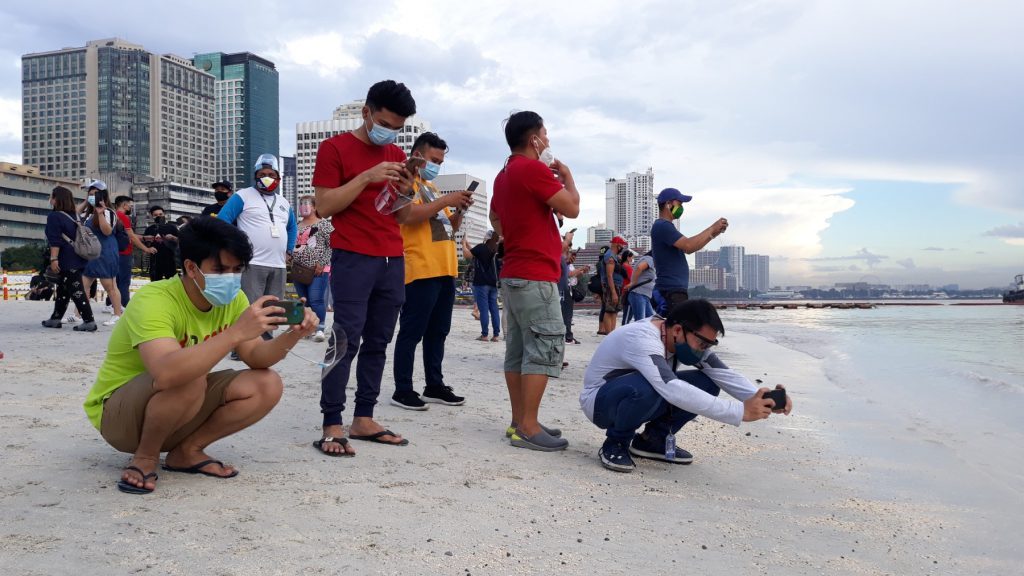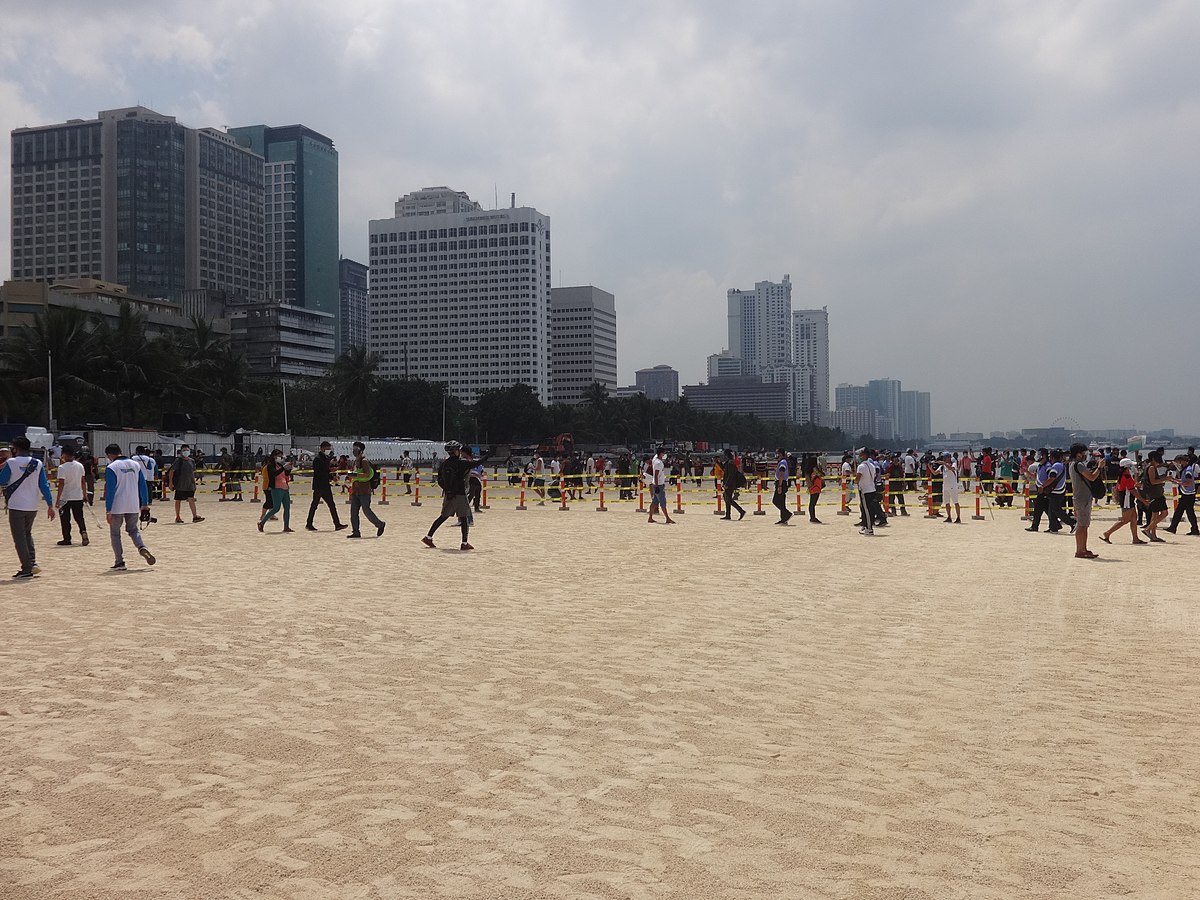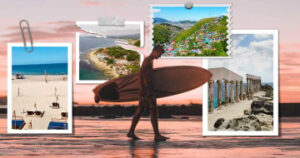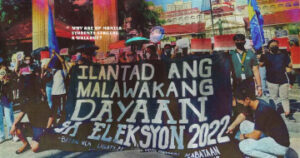
Last September 4, news broke out about the Department of Environment and Natural Resources launching its “whit beach” project in an effort to beautify Manila Bay.
Two weeks later, we’ve seen all the memes and the #ManilaBayChallenge photos, but how much of the notorious makeover, or “nourishment project” as DENR Undersecretary Benny Antiporda puts it, do we really know about? Here are some fast facts regarding the Manila Bay “white beach” project.
The size
To say that the white sand will cover the entire strip of Manila Bay is, well, misleading.
Here’s a helpful illustration, as shared by journalist Raffy Tima who made the size comparison on Google Maps:
The topmost photo is a mere portion of Manila Bay. The photo in the middle an even smaller portion of that bay usually referred to as the Manila Baywalk. The bottom photo is a tiny portion of that famous baywalk strip.
— Raffy Tima (@raffytima) September 19, 2020
Just saying.
In every story, context is king. pic.twitter.com/sSsCkCHFwX
As you can see, the white beach that opened to the public on September 19 only covered the baywalk in front of Roxas Boulevard, and not, in fact, the entire Manila Bay shoreline.
To be fair, Usec. Antiporda has stated that this is just “phase one” of Manila Bay’s planned enhancement project, and that the next phase will cover another 380 meter stretch of the baywalk.
The sand
The “white sand” is perhaps the most debated aspect of the project, tearing keyboard warriors into two camps. Let’s try to break it down (no pun intended):
What is it made of?
The “white sand” is actually crushed dolomite rock. Also called “dolostone,” dolomite is a non-metallic mineral mostly used as an aggregate in construction projects.
While dolomite is technically classified as a non-toxic, studies show that exposure to varying atmospheric concentrations of crystalline silica in dolomite is likely to lead to respiratory problems.
But that’s just on people; since the mineral does not naturally occur in Manila Bay, it can disrupt the bay’s ecosystem by increasing the bay’s total suspended particulate (TSP) levels, posing harm to aquatic life.
But to Environment Secretary Roy Cimatu, all these claims are “rubbish.” That’s despite the fact that according to OIC Director of Environmental and Management Bureau (DENR-EMB), the “white sand” project didn’t undergo the standard Environmental Impact Assessment (EIA). This goes against the Palace’s claim that the project wouldn’t have pushed through if it didn’t pass the EIA.
How long will it last?
According to University of the Philippines Resilience Institute executive director Mahar Lagmay, pouring dolomite onto Manila Bay is a poor choice, as sand is “always transported from one place to another” along beaches. Environmentalists seconded this, stating that, in the long run, it would cost the government more money to constantly replenish the synthetic sand.
Yet DENR insists that the project isn’t a waste of public funds. According to Usec. Antiporda, engineers used a “geo-tube” so that the sand can withstand being washed away during storms. They’re also looking into building seawalls to prevent the sand from further eroding.
Where does it come from?
The crushed dolomite rocks are mined from Barangay Pugalo in the small town of Alcoy, south of Cebu, by Dolomite Mining Corporation (DMC) as part of the 25-year Mineral Production Service Agreement between DMC and the local government of Cebu.
However, this “agreement” hasn’t exactly been smooth-sailing. Previously, Cebu government claimed to be “alarmed” when they discovered that the “white sand” to be used on Manila Bay were to come from Cebu’s dolomite mines. This led to Cebu Gov. Gwendolyn Garcia issuing a cease and desist order against DMC and Philippine Mining Services Corporation (PMSC), telling that the locally mined mineral is meant for foreign export only.
Yet the project persisted, and is still set to transport 10,500 wet metric tons of dolomite from the province to Manila. The mayor of Alcoy even claims that the local government has not received a single cent from mining operators sourcing dolomite rocks from their town.
On September 18, the Provincial Environment and Natural Resources Office (PENRO) of Cebu who has been studying the seawater in Alcoy, reported that due to the heavy dolomite siltation, corals within 500 meters from shore have been killed, and marine life has been dwindling.
The schedule
Prior to the “white sand” fiasco, the Manila Bay clean-up program has actually been in effect since January 2019. It started with a series of clean-up drives, water quality improvement, and relocation operations. To refresh everyone’s memories, from January up to October 2019, news regarding the Manila LGU spearheading the relocation of informal settlers living along Manila Bay had been rampant.
In January of this year, DENR finished the year-long clean-up of Baseco Compound, the infamous slums by the bay in Tondo.
So what’s next?
According to this roadmap posted by DENR, the next phase should include the rehabilitation of NCR’s decrepit sewer lines, and to fully relocate Manila Bay’s informal settlers.
The debate on whether the white sand in Manila Bay contributes to the big picture is yet to be decided. Let’s just hope the synthetic white sand lasts until the entire Manila Bay rehabilitation project is over, or that’s another P398 million down the drain.























